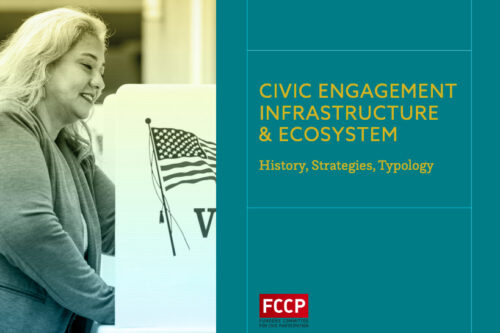More than ever, robust civic engagement is critical to ensuring we live in a just and equitable society. With the world altering changes we’ve seen in 2020—from the COVID-19 pandemic to urgent calls to counteract anti-Black racism and white supremacy—we recognize the acute need to continue strengthening philanthropic support of civic engagement efforts. However, navigating this funding field can be challenging without a clear understanding of the civic engagement landscape.
FCCP has produced a report to provide an introduction to the space and give greater context through a typology of the civic engagement ecosystem. We know the landscape is always growing and evolving, especially as evidenced by this summer’s powerful racial justice movement. So while the report predates these events, we believe it can continue to serve as a flexible framework for how we understand the existing infrastructure.
To bring the typology to life, a case study illustrates the kinds of organizations and practices that exist within Virginia’s civic engagement infrastructure.
Often through crises we are presented opportunities to think and act in ways that were not possible before. By growing our understanding of the landscape, we can build the needed support for a strong civic engagement infrastructure and a just democracy.
Support for this research was provided by the Robert Wood Johnson Foundation. The views expressed here do not necessarily reflect the views of the foundation.
About the Civic Engagement Typology
Civic engagement, as a sector of philanthropic strategy and investment, has grown and evolved exponentially in the last 25 years. Beginning narrowly as work to expand voter participation in impacted communities and promote fair and transparent electoral and judicial systems, now civic engagement includes litigation, issue advocacy, movement and power building, community and cultural organizing, racial justice campaigns, and electoral systems reform. Indeed, it is not unreasonable to ask – as many funders new to the sector do — what social and policy change efforts are not civic engagement? Truth be told, given our social and political moment, not many.
In short, civic engagement is increasingly the how of efforts to align civil society and the public sector around shared values, policies, and a vision for a more widely prosperous, just, and inclusive democracy. Growing numbers of funders from across the issue spectrum see that progress on their objectives must include an ongoing funding commitment to the theories and practices of civic engagement.
This expanded role has resulted in a broad and highly developed civic engagement infrastructure of organizations, capacity builders, and funders who together seek to aggregate the totality of relevant resources and relationships in service of social justice and policy change.
This infrastructure consists of a dense and ever more nuanced constellation of groups, leaders, ideas, voices, strategies, tools, experiments, and community, state, and national networks — all aimed at promoting a vibrant and humane democracy.
FCCP’s typology attempts to schematize the current civic engagement infrastructure in ways that both reflect work on the ground and offer funders new to the field a conceptual framework by which to understand the form and substance of civic engagement work. Such a typology, inevitably a static snapshot of a highly dynamic context, is anachronistic almost the day it is formed. This is especially true now when powerful racial justice movements and the urgency of the 2020 election create innovative avenues and voices for civic engagement and social change.
Nonetheless, the fundamental pillars of the civic engagement infrastructure have been and continue to be:
- Civic engagement organizations
- Capacity builders and tools providers
- Funders
These are engaged and coordinated at the local, state, and national levels, and enroll grassroots, faith based, issue and policy advocacy, and systems reform partners. This interconnectivity is what makes the civic engagement sector exciting and impactful.
The task of democracy is always a moment by moment commitment. This has never been more true than now: when every major institutional, procedural, and ethical foundation is under threat and reconsideration. Insofar as progress is initiated in civil society, nonpartisan civic engagement investment is the best conduit to public interest change.
FCCP’s typology of the civic engagement infrastructure provides an historical and architectonic orientation to philanthropy’s understanding of and investment in this crucial social change work.
